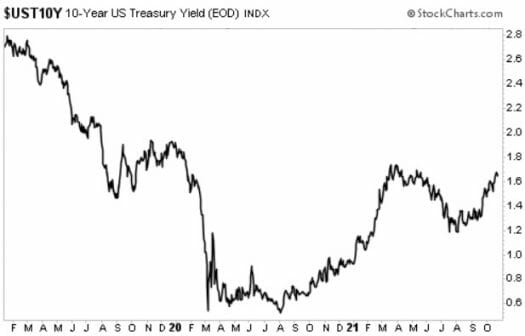This Sector Will Do Even Better When Rates Go Up…
There is one sector — perhaps above all others — that can’t wait to see the end of this historically low rate environment: the financial sector.
In fact, last week, I featured a quote from one of its leaders, Jamie Dimon, CEO of JP Morgan Chase (NYSE: JPM). He said the bank was “stockpiling” cash, waiting for better opportunities to invest that money at higher rates.
While rates have begun creeping upward (shown in the 10-year Treasury chart below), I’m betting you probably haven’t noticed much of a difference in the meager yields offered by your bank or credit union.

According to Bankrate, the national average for a bank savings account is still a microscopic 0.06%. CD rates are a tad more generous, but they haven’t budged either. Over the past three months, one-year CD rates have actually slipped a couple of points from 0.15% to 0.17%.
That’s almost free money for banks to redeploy elsewhere.
The point is, these rates paid out to depositors will grudgingly inch their way higher over time, tick by tick. But it will be a gradual process. Do you think the rates that banks charge borrowers will respond more quickly? You better believe it. While deposits will remain a low-cost source of funding, the rates attached to car notes, mortgages, commercial loans, and credit cards will climb more quickly – thereby widening the spread.
That spells opportunity for investors.
Rising Rates = Rising Profits…
It’s only a matter of time before banks and other lenders enjoy a long-overdue expansion in net interest margins (NIM). And when you have billions in loans outstanding, every point matters. At the same time, these companies will also collect greater income from the massive piles of assets sitting on their balance sheets.
Not that they are hurting now.
Strong earnings from the major banks have helped spark a renewed surge in the major market averages. Bank of America (NYSE: BAC), which now has over $1 trillion in deposits, reported an impressive 58% increase in quarterly profits. That bottom-line growth was driven largely by $10 billion in net interest income (NII), to say nothing of hefty asset management and investment banking fees.
The bank had set aside billions in reserves to cover expected losses during the pandemic. But that default wave never happened. Non-performing loans remain quite low, and charge-offs are approaching a 50-year low. So those loan reserves have been freed up and released – one reason why the bank just raised its dividend by 17%.
Action to Take
Add it all up, and investors would be wise to take a look at this sector right now. But aside from the usual suspects (like JPM and BAC), I’d encourage especially income-minded investors to take a broader look…
For example, the smaller banking players are doing okay, too. Take one of our former holdings over at my premium High-Yield Investing service, Bank OZK (NYSE: OZK), which we parted from last year after a quick 49.8% gain. Citing its disciplined lending and improved loan loss provision, the bank just posted a strong 199.5% increase in quarterly profits. Earnings tripled from $0.39 to $1.16 per share – shattering the previous record.
OZK has lifted dividends for 45 consecutive quarters. And yet, with the Fed keeping short-term rates anchored near zero, its net interest margin of 3.95% is still lean by historical standards. The same is true of most in this sector.
So what will bank earnings (and dividends) look like once borrowing costs begin to bounce back towards normal levels? That’s a good question. But it’s not the one you should be asking. As Warren Buffett would council, predicting rain doesn’t count; building arks does. It would be far more instructive to determine which lenders have the most to gain.
This is one of the reasons why I like business development companies (BDCs). With borrowings typically locked in at fixed rates and loans left to float, these will be a key beneficiary of the changing interest rate winds. Even better, BDCs often pay two to three times the yield of your average bank.
This is why I recently added a BDC to our portfolio over at High-Yield Investing. And it’s also why I talk about BDCs in my latest report…
In this low-rate environment, it’s been tougher than ever for investors to find high income. But the opportunities are out there, if you know where to look… And in my report, you’ll find 5 “bulletproof” high-yield stocks that you can own for the long-term — picks that are so solid, they’ve weathered every dip and crash over the last 20 years and still handed out massive gains.
